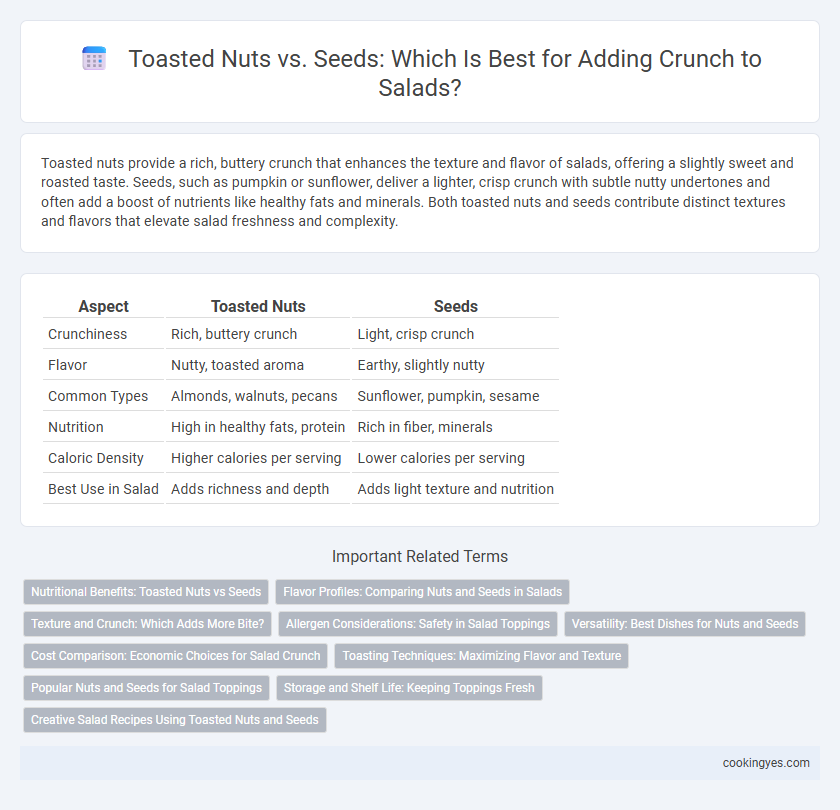Toasted nuts provide a rich, buttery crunch that enhances the texture and flavor of salads, offering a slightly sweet and roasted taste. Seeds, such as pumpkin or sunflower, deliver a lighter, crisp crunch with subtle nutty undertones and often add a boost of nutrients like healthy fats and minerals. Both toasted nuts and seeds contribute distinct textures and flavors that elevate salad freshness and complexity.
Table of Comparison
| Aspect | Toasted Nuts | Seeds |
|---|---|---|
| Crunchiness | Rich, buttery crunch | Light, crisp crunch |
| Flavor | Nutty, toasted aroma | Earthy, slightly nutty |
| Common Types | Almonds, walnuts, pecans | Sunflower, pumpkin, sesame |
| Nutrition | High in healthy fats, protein | Rich in fiber, minerals |
| Caloric Density | Higher calories per serving | Lower calories per serving |
| Best Use in Salad | Adds richness and depth | Adds light texture and nutrition |
Nutritional Benefits: Toasted Nuts vs Seeds
Toasted nuts in salads provide higher levels of healthy monounsaturated fats and essential minerals like magnesium and copper, which support heart health and immune function. Seeds, such as pumpkin and sunflower, offer superior amounts of dietary fiber, plant-based protein, and zinc, enhancing digestion and boosting immune response. Both toasted nuts and seeds contribute valuable antioxidants, but seeds often contain more phytosterols that help reduce cholesterol levels.
Flavor Profiles: Comparing Nuts and Seeds in Salads
Toasted nuts such as almonds, walnuts, and pecans offer rich, buttery flavors with a slightly sweet and smoky undertone that enhances salad complexity. Seeds like pumpkin, sunflower, and sesame provide a nuttier, earthier taste with a subtle bitterness that balances fresh greens and vinaigrettes. Both nuts and seeds contribute distinctive crunch and flavor dimension, with nuts delivering a more robust, creamy texture while seeds impart a lighter, crisp bite.
Texture and Crunch: Which Adds More Bite?
Toasted nuts provide a richer, crunchier texture in salads, delivering a satisfying bite due to their density and natural oils that crisp up during toasting. Seeds, while offering a lighter crunch, add a delicate crispness that complements softer salad ingredients without overpowering them. Choosing between toasted nuts and seeds depends on the desired salad texture: nuts for bold crunch and seeds for subtle crispness.
Allergen Considerations: Safety in Salad Toppings
Toasted nuts, such as almonds and walnuts, provide a rich crunch but pose a higher allergen risk compared to seeds like pumpkin or sunflower seeds, which are generally safer for people with nut allergies. Seeds offer a crunchy texture with lower potential for triggering common allergies, making them a preferred choice in salad toppings for allergy-sensitive individuals. Selecting seeds over nuts can enhance salad safety while maintaining texture and nutritional benefits.
Versatility: Best Dishes for Nuts and Seeds
Toasted nuts bring a rich, buttery crunch ideal for hearty salads featuring roasted vegetables, grains, or cheeses, enhancing flavors with their deep, toasted notes. Seeds, such as pumpkin or sunflower, offer a lighter, earthier texture perfect for fresh green salads, grain bowls, and dressings, adding subtle nuttiness without overpowering delicate ingredients. Both toasted nuts and seeds elevate salads by providing contrasting textures and complementing a wide range of dishes, from Mediterranean to Asian-inspired recipes.
Cost Comparison: Economic Choices for Salad Crunch
Toasted nuts generally cost more than seeds but provide a richer flavor and crunch, making them a premium choice for salads. Seeds such as sunflower or pumpkin seeds offer a budget-friendly alternative while still delivering excellent texture and nutritional value. For cost-effective salad crunch, seeds balance affordability with taste, whereas nuts cater to higher-end salad recipes.
Toasting Techniques: Maximizing Flavor and Texture
Toasted nuts enhance salads by developing rich, deep flavors and a satisfying crunch through dry roasting or oven toasting at moderate temperatures around 325degF (163degC) for 5-10 minutes, ensuring even browning without burning. Seeds, such as pumpkin or sunflower, benefit from quick toasting in a dry skillet over medium heat, which releases natural oils and intensifies their nutty aroma while maintaining a crisp texture. Proper toasting techniques maximize the flavor complexity and textural contrast in salads, elevating the overall sensory experience.
Popular Nuts and Seeds for Salad Toppings
Toasted almonds, walnuts, and pecans are popular nuts that add a rich, buttery crunch to salads while boosting protein and healthy fats. Common seeds like pumpkin, sunflower, and sesame seeds offer a crisp texture alongside essential minerals and antioxidants. Both nuts and seeds enhance salad flavor profiles and contribute to nutrient density, making them ideal toppings for a satisfying crunch.
Storage and Shelf Life: Keeping Toppings Fresh
Toasted nuts for salad toppings require airtight containers stored in a cool, dark place to maintain freshness and prevent rancidity, typically lasting up to three months. Seeds, when properly stored in sealed containers and refrigerated, can stay fresh for six months or longer due to their lower oil content. Proper storage of both nuts and seeds preserves crunch and flavor, enhancing the overall salad experience.
Creative Salad Recipes Using Toasted Nuts and Seeds
Toasted nuts like almonds, pecans, and walnuts enhance salad crunch with rich, buttery flavors and a satisfying texture that complements fresh greens. Seeds such as pumpkin, sunflower, and sesame add a nutty, earthy element while boosting nutritional value with healthy fats and protein. Creative salad recipes often combine toasted nuts and seeds to create a balanced crunch, enhancing taste and adding depth to vibrant, layered salads.
Toasted nuts vs Seeds for salad crunch Infographic

 cookingyes.com
cookingyes.com